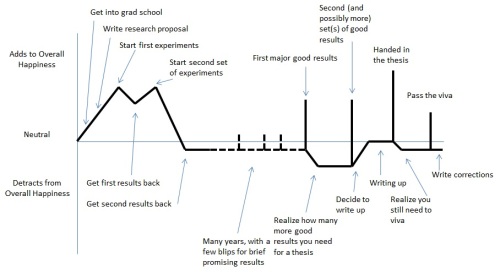Please switch and join me on my new blog Science Snapshot! It’s my latest project – one academic scientific paper is picked per day, and I write about it from a general science background, explaining all the types of science going on across the world. http://www.sciencesnapshot.wordpress.com
Category Archives: Uncategorized
Last posting – a forward-thinking retrospective
Dear readers,
It is both happily and sadly that I inform you that this will be my last posting for the makingbones blog. This is because I have now completed my DPhil (happy) but will now be moving on to other stages of my life (sad, but happy). When I first set out to do my DPhil I had no idea that it would be the emotional and intellectual roller coaster that it has been. Here are some of the ideas I had going into the process, compared to my actual experiences.
1) I thought I would be done in 3.5 years. It took 5. Research from 3.5 years of the total featured only in the appendices of the thesis.
2) I thought my experiments would look a bit like this:
Instead, they looked like this (actual flow chart from a poster I presented at a conference):
3) Up until grad school, my academic achievements were a source of happiness and confidence. Scientific research as a career (starting in grad school) often has a different effect. I’ve learnt to not attach my confidence to the results of experiments – after all, if we knew the answers it wouldn’t be called “research”.
4) Throughout your time in grad school you may work with one or many supervisors. Know yourself and what kind of help you need from these people – if they do not give you the support you need, look elsewhere, and sooner rather than later. But be kind to them.
Thanks to all of you who have read my blog over the past year! Best of luck with your decisions on grad school! And if you do decide to undertake this adventure, go in with an open mind, stay confident in yourself, and see where it takes you!!
Growing more enamel in our sleep?
The following is a draft of a short piece written for the National Institute of Dental and Craniofacial Research.
The concept of circadian rhythms, that is, the regulation and fluctuation of biological processes over a 24-hour period, has always been a popular idea. Are blind animals still attuned to what time of day it is? Can humans kept in special chambers on 28 hour days function normally? How do long-distance airline pilots cope with multiple time zone, and the accelerated/decelerated daylight exposure?
Although long based on empirical observation, modern science has allowed researchers to find the biochemical evidence of a circadian clock, and to study this phenomenon all the way down to the genetic level, and in organisms as far back as a simple fungus. A group of scientists funded by the NIDCR set out to answer the question:
“Do we grow more enamel in our sleep?”
In order to answer this question we have to discuss previous work that has been done in the field of enamel biochemistry. Previous scientists had done staining experiments that showed bursts of enamel being deposited on a daily basis, as contrasted to a slow, steady, build-up. Because this was on a 24-hour rhythm, speculation arose that the process might be circadian.
Enamel growth has been shown to be two-step process: the production of a protein matrix made of amelogenin and other enamel-specific proteins followed by the deposition and growth of bicarbonate crystals as directed by this matrix and concomitant removal of matrix. Snead et al. set out to show that these two steps were directly related to the circadian clock, with protein matrix being grown during light hours and crystal growth occurring during dark hours.
The group of researchers attacked the problem through three different analysis methods. Gene sequence analysis was carried out to see if promoter sequences known to be circadian-clock-regulated (E-box sequences) were associated with enamel-specific protein and crystal production genes. Through the culturing of circadian-synchronized cells and the dissection of molars from pups kept in a strictly circadian environment, RNA was extracted and analysed at 4 hour intervals to see if enamel genes showed fluctuation in a circadian-specific manner. Additionally, to demonstrate the presence of circadian-regulating proteins in the mice, molars were extracted and stained for these proteins. Thus, through DNA analysis, gene and protein expression analysis, the scientists were able to conclude that the two steps of enamel production did indeed take place sequentially and on a 24-hour cycle.


